Mariya V. Dobrovolskaya*, Grigory L. Zemtsov**, Anna V. Mastykova*, Mariya B. Mednikova*
* Institute of Archaeology Russian Academy of Sciences, Moscow
(mk_pa@mail.ru; amastykova@mail.ru; medma_pa@mail.ru)
** Lipetsk State Pedagogical University (grizem@rambler.ru)
Keywords: a privileged barrow, a costume witth golden aplications, the Hun Age, Upper Don region, the north Black Sea region, bioarchaeology, paleobotanics.
 The article considers the female burial 1 found in the multilayer settlement Mukhino 2 (Zadonsky District of Lipetsk Oblast) on the left bank of the river Snova not far from its inflow into Don. The anthropological research of the skeleton remains has showed that they belong to a woman of 20–29 years old. The burial 1 from the settlement Mukhino 2 contains grave goods, which are typical for the “barbarian” nobility of the Hun Age that testifies a high social status of the buried woman. Her attire corresponds with the cultural tradition of a nomad people of the late ancient centres of the southern Black Sea region. Based on the combination in the grave goods, the Mukhino burial could be referred to the end of the period D2 – the beginning of the period D2/D3 of the “barbarian” European chronology that is to say approximately to 430–450. The morphological characteristics of the postcranial skeleton of the buried woman allow concluding her gracility. The comparison with the early studied Sarmatian and Alan woman samples from the “elite board” of the complex Klin-Yar helps to reveal some similarity features. According to the isotopic and elemental analysis it has been determined that animal protein was not prevailed in the food ration of the buried woman but the plants of a photosynthesis type C4 (probably, millet) comprised the significant part of it which could be interpreted as a marker of a sedentary life. This suggestion finds its additional confirmation in the results of the paleobotanical researches of the sites from the whole region. The set of reasons received while studying the skeleton remains shows at the possible southern origin of the burial.
The article considers the female burial 1 found in the multilayer settlement Mukhino 2 (Zadonsky District of Lipetsk Oblast) on the left bank of the river Snova not far from its inflow into Don. The anthropological research of the skeleton remains has showed that they belong to a woman of 20–29 years old. The burial 1 from the settlement Mukhino 2 contains grave goods, which are typical for the “barbarian” nobility of the Hun Age that testifies a high social status of the buried woman. Her attire corresponds with the cultural tradition of a nomad people of the late ancient centres of the southern Black Sea region. Based on the combination in the grave goods, the Mukhino burial could be referred to the end of the period D2 – the beginning of the period D2/D3 of the “barbarian” European chronology that is to say approximately to 430–450. The morphological characteristics of the postcranial skeleton of the buried woman allow concluding her gracility. The comparison with the early studied Sarmatian and Alan woman samples from the “elite board” of the complex Klin-Yar helps to reveal some similarity features. According to the isotopic and elemental analysis it has been determined that animal protein was not prevailed in the food ration of the buried woman but the plants of a photosynthesis type C4 (probably, millet) comprised the significant part of it which could be interpreted as a marker of a sedentary life. This suggestion finds its additional confirmation in the results of the paleobotanical researches of the sites from the whole region. The set of reasons received while studying the skeleton remains shows at the possible southern origin of the burial.







